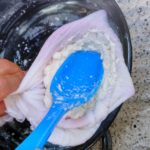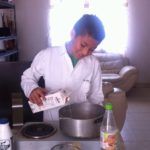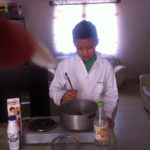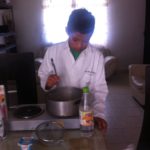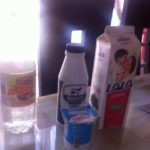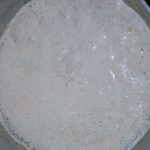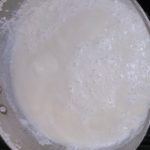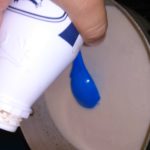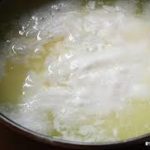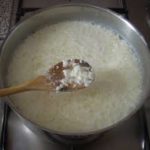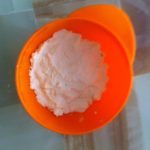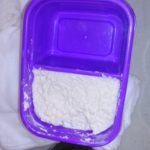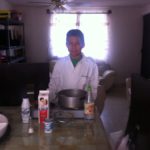QUESO CASERO
QUESO CASERO
Categoría: Pandilla Kids (3ro., 4to., 5to. y 6to. Año de primaria)
Área de participación: Ciencias Agropecuarias y de Alimentos
Resumen
El queso es un alimento sólido elaborado a partir de la leche cuajada de vaca, cabra, oveja, búfala, camello u otros mamíferos.
Según la OMS:”es el producto fresco o madurado obtenido por la coagulación y separación de la leche, nata, leche parcialmente desnatada, mazada o por una mezcla de estos productos”.
De acuerdo a la composición: ”es el producto fermentado o no constituido esencialmente por la caseína de la leche, en forma de gel más o menos deshidratado que retiene casi toda la materia grasa, si se trata de queso graso, un poco de lactosa en forma de ácido láctico y una fracción variable de sustancias minerales
El principal ingrediente del queso es sin duda la leche y para aquellos que nos gusta hacer queso en casa, sobre todo en zonas urbanas, se nos plantea el reto de encontrar la mejor leche posible. Si hablamos de leche de vaca, mi consejo es usar leche pasteurizada fresca (de venta en la sección refrigerada de los supermercados) y evitar la leche UHT en tetra-brik que nos va a dar resultados pobres. Si hablamos de leche de cabra u oveja, yo he conseguido hacer quesos razonablemente buenos con leche en tetrabrik, posiblemente porque estas leches son más grasas que la de vaca
Durante algunos días busque modos diferentes de realizar un queso
1 vez.- utilice 2 litros de leche, ½ litro de yogurt natural, 1 limón y un poco de sal.
Puse a calentar todos los ingredientes aproximadamente a los 15 minutos empezó a hervir, cuando empezó a cortarse la leche apague el fuego y vertí el líquido sobre una manta la manta separo el suero y lo que quedo en la manta lo metí al refrigerador durante 5 horas. Cuando lo saque estaba listo para comer.
2 vez.- utilice solo la leche y agua, hice el mismo método de la vez anterior teniendo un resultado muy similar
Hice el queso con diferentes ingredientes en alguno agregue mantequilla, en otros no deje cuajar tanto la leche, en otros lo guarde para su añejamiento pero siempre utilizando la misma materia prima (leche) y utilizando el mismo método.
3 vez utilice coagulante de origen microbiano pero como la leche tenía que estar a una temperatura específica y yo no tenía los instrumentos necesarios para medir la temperatura no pude llegar a un resultado favorable.
Pregunta de Investigación
¿Cómo realizar un queso casero?Planteamiento del Problema
¿Cómo puedo realizar queso casero saludable y sin conservadores?
¿Podré realizar un queso casero nutritivo y rico?
¿Cuántas clasificaciones de queso podre realizar en mi casa?
Antecedentes
El queso es una comida antigua cuyos orígenes pueden ser anteriores a la historia escrita. Descubierto probablemente en Asia Central o en Oriente Medio, su fabricación se extendió a Europa y se había convertido en una empresa sofisticada ya en época romana. Cuando la influencia de Roma decayó, surgieron técnicas de elaboración de queso locales diferentes.
La elaboración del queso seguramente fue descubierta por diversas comunidades al mismo tiempo. Las ovejas fueron domesticadas hace 12,000 años y en antiguo Egipto se cuidaban vacas y se les ordeñaban para tener la leche por lo que es lógico pensar que también harían quesos. La leche se conservaba en recipientes de piel, cerámica porosa o madera.
Los pastores, granjeros, monjes, con mucha paciencia, muchos intentos fallidos o exitosos, fueron haciendo pruebas hasta ir consiguiendo la variedad de quesos, que ahora conocemos.
Se sabe que el tipo de leche (vaca, oveja, cabra, camella, etc.…), la clase de la leche (más grasa o menos debido a los pastos del terreno), el clima (cada región imprime una marca especial o una diferencia en el tipo de queso), la coagulación, la maduración, la fermentación, dan lugar a los diferentes tipos de queso.
Objetivo
Realizar un queso casero totalmente natural y sin conservadores.
Justificación
Hace algunos meses fui de vacaciones a Durango con unos familiares lejanos y conociendo sus costumbres me platicaban que ellos hacían su propio queso aprovechando sus recursos naturales.
En la actualidad la vida en la cuidad es muy aprisa las personas vivimos corriendo, los papás y mamás trabajan por lo que la comida se compra refrigerada o lista para calentar y servir; estos alimentos están muy procesados en algunos casos tienen muchos químicos y conservadores por lo que no es tan sana esta alimentación, lo que nos lleva a enfermedades como la diabetes o sobrepeso.
Pensé que si hacia queso casero podría crear algo de conciencia de que necesitamos comer más saludablemente.
Hipótesis
Si todos comiéramos productos saludables tendríamos una mejor calidad de vida y nos enfermaríamos menos.
Si realizo un queso casero natural y sin conservadores entonces podría darle una mejor nutrición a mi familia.
Método (materiales y procedimiento)
Materiales: leche, vinagre, limon, cuajo, yogurt nartural, sal, una olla, una cuchara grande, un colador, tela, un recipiente donde regrigerar
1.- Poner la eche a hervir.
2.- Cuando este hirviendo colocar una cucharada de vinagre. (otra receta es con 2 limones y 1 un yogurt natural) (poner una cucharda de cuajo)
3.- Mover hasta que el suero se separe.
4.- Colocar la tela sobre el colador.
5.- Vertir el liquido y enjuagar un poco.
6.- Esperar a que escurra todo el suero.
7.- Amasarlo y ponerle sal.
8.- colocarlo en un recipiente a regrigerar.
Resultados
El primer queso tenía una consistencia muy parecida al queso que compra mi mama, no lo quise probar pero lo lleve a casa de mi abuelita y les dije que lo probaran sin que supieran que era el que hice yo, su respuesta fue que estaba bueno pero no tenía sal.
En los siguientes intentos me pase de sal, unos me quedaron muy húmedos, unos parecían requesón y ya los últimos me quedaron exactamente igual que el queso crema.
Hubo cosas que afectaban la consistencia como la mantequilla y hubo otros que mejoraban su sabor con especies.
Discusión
Hacer el queso casero parecia mas facil cuando leia las recetas pense en hacer diferentes estilos pero realmento no es tan sencillo cada uno lleva su tiempo y sus cuidados, a mi siempre me salia bien el queso crema y entonces decidi hacerlo hasta encontrar llegar a un buen sabor y textura.
Descubri que me ayudo a trabajar en compañia de mis abuelitas y fue divertido.
Aunque en un principio nadie queria provar mis quesos pocoa poco mi familia le fue gustando y nos dimos cuenta que en una actividad familiar podemos hacer algo sano y nutritivo.
Conclusiones
Realizar el queso casero no es tan difícil contando en que puede ser una actividad familiar muy divertida, por lo que aconsejo que lo intenten en sus casas.
Cuando realizas un queso casero descubres que hay alimentos naturales que pueden ser muy sabrosos y que si poco a poco agregas más cosas saludables a tu alimentación tendrás una vida más sana.
Hice el proceso en diferente ocasiones y en todas me dio diferentes resultados, algunos quesos no tenían tan buen sabor, en otros no logre el añejamiento, otros aunque eran ricos de sabor su textura era rara, por lo que llego a la conclusión que con un más practica llegare a hacer un queso casero muy rico y saludable
Bibliografía
Las personas que habitan el Estado de Durango Colonia 5 de Julio
https://es.wikipedia.org/wiki/queso
www.poncelet.es/enciclopedia-del-queso
QUESO CASERO
QUESO CASERO
Summary
Cheese is a solid food made from curdled milk cow, goat, sheep, buffalo, camel or other mammals.
According to WHO, "It is the fresh or matured obtained by coagulation and separation of milk, cream, partly skimmed milk, buttermilk or a mixture of these products product".
According to the composition: "It is more or less dehydrated fermented or consisting essentially of casein milk in the form of gel product that retains almost all fat, if it comes to fat cheese, a little lactose form lactic acid and a variable fraction of mineral substances
The main ingredient of cheese is definitely the milk and for those we like making cheese at home, especially in urban areas, we face the challenge of finding the best possible milk. If we talk about cow's milk, my advice is to use fresh pasteurized milk (sold in the refrigerated section of supermarkets) and avoid UHT milk in tetra-brik we will give poor results. If we talk about goat or sheep milk, I managed to do reasonably good cheese with milk carton, possibly because these milks are more fat than cow's milk
For a few days look for different ways to make a cheese
1 time.- use 2 liters of milk, ½ liter of yogurt, 1 lemon and a little salt.
I put to heat all the ingredients at about 15 minutes began to boil when he began to cut milk out the fire and poured the liquid on a blanket blanket separated serum and what was left on the blanket I put it in the refrigerator for 5 hours . When you remove it was ready to eat.
2 time.- use only milk and water, did the same method the previous time having a very similar result
Cheese made with different ingredients in one add butter, others do not let curdle milk both in others keep it for your aging but always using the same raw material (milk) and using the same method.
3 times using microbial coagulant but like milk had to be at a specific temperature and I did not have the necessary instruments to measure temperature could not reach a favorable outcome.
Research Question
How to make a homemade cheese?Problem approach
How I can make healthy homemade cheese without preservatives ?
Can I make a nutritious and delicious homemade cheese ?
How many classifications Podre make cheese at home?
Background
Cheese is an ancient food whose origins may predate written history. probably discovered in Central Asia or the Middle East, manufacturing spread to Europe and had become a sophisticated enterprise in Roman times. When Rome's influence waned, they emerged processing techniques different local cheese.
The cheese was discovered by surely diverse communities at the same time. Sheep were domesticated 12,000 years ago and in ancient Egypt cows were milked and tended to have milk so it is logical to think that would also make cheese. The milk is kept in containers of skin, porous ceramic or wood.
Shepherds, farmers, monks, patiently, many failed or successful attempts were auditioning to be getting the variety of cheeses, we now know.
It is known that the type of milk (cow, sheep, goat, camel, etc. ...), the kind of milk (more fat or less due to pasture terrain), climate (each region print a special mark or difference in the type of cheese), coagulation, ripening, fermentation, resulting in different types of cheese.
Objective
Perform a totally natural and without preservatives homemade cheese.
Justification
A few months ago I went on vacation to Durango with distant relatives and knowing their customs talked me they made their own cheese using its natural resources.
Today life in the city is very quick people live running , working moms and dads so the food is purchased chilled or ready to heat and serve ; these foods are heavily processed in some cases they have many chemicals and preservatives so it is not as healthy this food, which leads to diseases such as diabetes or overweight.
I thought if to homemade cheese could create some awareness that we need to eat more healthfully.
Hypothesis
If we all ate healthy products would have a better quality of life and we enfermaríamos less.
If I make a natural homemade cheese and no preservatives then it could give better nutrition to my family.
Method (materials and procedure)
Materials: milk , vinegar , lemon , rennet, nartural yogurt , salt, a pot , a large spoon, a colander , cloth, a container where regrigerar
1. Put the take to boil.
2. When boiling place a spoonful of vinegar. (Another recipe is 2 lemons and 1 natural yogurt) (put a cucharda rennet )
3. Move until the whey separates .
4. Place the cloth over the strainer.
5. Pour the liquid and rinse a little.
6. Wait until all the whey drain.
7. Knead and add salt.
8. place it in a container regrigerar.
Results
The first cheese had a consistency much like cheese you buy my mom , I did not want to try but take home my grandmother and told them to prove without them knowing it was I did, his response was that it was good but he had no salt .
In the following I pass attempts salt , some left me very wet , some cottage cheese and looked past me and were exactly like cream cheese .
There were things that affected the consistency like butter and were others who improved their flavor with spices.
Discussion
Make the easiest homemade cheese looked like when you read the recipes thought I'd do different styles but realmento is not so simple everyone takes time and care, I always came out cream cheese and then decided to do it until you reach a good taste and texture.
I found that helped me to work in the company of my grandmothers and it was fun .
Although at first nobody I wanted provar my little cheese pocoa my family was enjoying it and we realized that a family activity can do something healthy and nutritious .
Conclusions
Perform homemade cheese is not as difficult counting can be a fun family activity , so advise you to try at home.
When you make a homemade cheese you discover that there are natural foods that can be very tasty and if gradually add more healthy things to your diet can have a healthier life .
I made the process different occasions and all I gave different results, some cheese did not taste as good , others not achieve the aging process , others though were rich flavor texture was rare , so I conclude that a more practical cometh to make a rich and healthy homemade cheesel
Bibliography
People living in the State of Durango Cologne on July 5
https://es.wikipedia.org/wiki/queso
www.poncelet.es/enciclopedia-del-queso


